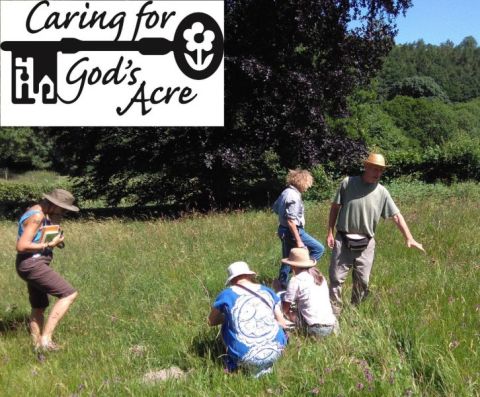The Beautiful Burial Ground Project on iRecord
Article by Liam Taylor | Data Manager | The Beautiful Burial Ground Project
About us
'Caring for God’s Acre' works nationally to support groups and individuals to investigate, care for, and enjoy burial grounds. We began as a small Shropshire based initiative in 1997 after being inspired by the National Living Churchyard and Cemetery Project (LCCP). Now in 2019, we are running events all across the country, from Yorkshire to Devon. There is more information available on our website and you can join our newsletter mailing list here.
Our charity is often mistaken for a religious organisation due to the associations our charity name can conjure in the mind. The name is inspired by the poem ‘God’s-Acre’ by Henry Wadsworth Longfellow. We are a non-religious charity, and although we have a diverse range of small projects, the thread that runs through it all is a passion for ecology. We are an inclusive organisation, and although we have close associations with some religious organisations, such as the Church of England, we enjoy working with a wide variety of groups and individuals. Due to the diverse nature of our projects, we work with an equally diverse group of individuals and organisations: mental health workers, archaeologists, ecologists, local councils, green burial ground owners, church wardens, national government organisations, and Local Environmental Record Centres, to name but a few.
“I like that ancient Saxon phrase, which calls
The burial-ground God's-Acre. It is just;
It consecrates each grave within its walls,
And breathes a benison o'er the sleeping dust.”
- Excerpt from the poem God’s-Acre by Henry Wadsworth Longfellow
We estimate that there are over 20,000 burial grounds in England and Wales, ranging from small rural medieval churchyards to large Victorian city cemeteries, spanning different cultures, religions and centuries. These sites encapsulate the history of communities, whilst offering much needed refuge for our native wildlife. For many people their local burial ground is the only accessible green space. The heritage value of burial grounds, and even their continuing presence, cannot be taken for granted. They are threatened by development, closure, lack of management and mismanagement.
Heritage Lottery
In 2017 we got the tremendously encouraging news that the Heritage Lottery Fund were providing funding for our Beautiful Burial Ground project. Our aims are to inspire, engage and support interest groups, communities and individuals to learn about, research and survey the biodiversity and heritage of their local burial grounds – churchyards, cemeteries, natural and green burial grounds.
NBN Atlas
One of the most important aspects of our project is to develop a ‘portal’ on the National Biodiversity Network (NBN) Atlas where anyone will be able to access records for any burial ground in England and Wales (with aspirations for full UK coverage in the future). The Beautiful Burial Ground Portal is currently in development with the NBN team, and we hope to have full functionality within the next few months. In theory, anyone will be able to visit the portal, search for any cemetery or churchyard and easily view the relevant records. This process depends on the creation of digital boundaries, and will take time. We are very grateful to the Church of England and their Church Heritage Record team for undertaking this work and sharing the results with us. The initial areas available on the portal will be North London, Manchester, and West Suffolk; over time coverage of all England and Wales will be made available.
Recording Solutions
We aspire to increase the number of records and recording coverage of burial grounds. We particularly want to engage in structured surveying protocols to publish research relating to burial grounds. We have plans for a national research collaboration with The Botanical Society of Britain and Ireland (BSBI). Locally we are working with the Shropshire Ecological Data Network (SEDN), to galvanise Shropshire recorders and target their efforts. We welcome any suggestions for any other specific research projects or collaborations.
Significantly, one of the first barriers to encouraging greater levels of recording was the lack of a suitable method for submitting records. Historically we kept ad hoc paper records, and in recent years we had ad hoc digital records in various different formats: word, .pdf, emails, and excel spreadsheets. The solution iRecord provides would be easy to take for granted; a standardised record format, a simple pathway to the NBN Atlas, easy to access and use, free, and a clear open data ethos. All boxes ticked, we would be lost without iRecord now.
All the records we produce as part of the project are uploaded to iRecord. We have an external iRecord activity form on our website, which we direct all of our potential recorders towards; this has been received positively by our volunteers. We work with many individuals who are interested in wildlife, and take great pleasure in considering and managing for the flora and fauna in their burial ground. However, many of these people would not consider themselves biological recorders. iRecord offers us an elegant and gentle way of encouraging someone to dip a toe in the deep waters of biological recording that we all enjoy swimming in.
20 people have joined our activity so far. Our team find it most encouraging when we see someone new has signed up. There have been 2832 records contributed to date. Please join the activity; any records you can contribute are greatly received. You can join our newsletter mailing list here.
This article was published in the BRC Newsletter February 2019

